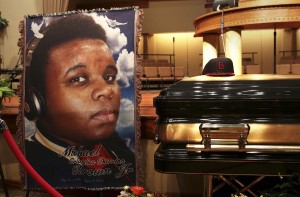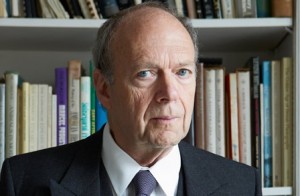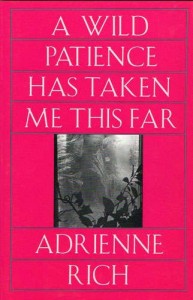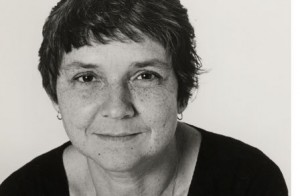These days it can be hard to tell the difference between what I am thankful for and simply privileges. I become more grateful each year for the opportunity to attend a top-notch liberal arts university, and to have the good fortune of family, education, home, food, and friends. Yet amid all I have to be thankful for this holiday season, it is my white  privilege that hangs heaviest in my heart this week. Although Shenandoah is a place of literary rather than political debate, I would feel remiss to not mention Monday night’s announcement that the officer responsible for the death of Michael Brown, an unarmed black teenager, will not be indicted. I think for most of the country grappling with this news a grim cloud looms over our Thanksgiving festivities. I know that personally my sense of American patriotism feels acutely heightened during this season of gratitude. But this year, it is hard for me to consider the United States a nation of prosperity and freedom, when so many of my opportunities are made possible by the chance color of my skin. In contrast, people of color are still denied full protection under the law and deprived of equal access to justice and dignity in their everyday lives.
privilege that hangs heaviest in my heart this week. Although Shenandoah is a place of literary rather than political debate, I would feel remiss to not mention Monday night’s announcement that the officer responsible for the death of Michael Brown, an unarmed black teenager, will not be indicted. I think for most of the country grappling with this news a grim cloud looms over our Thanksgiving festivities. I know that personally my sense of American patriotism feels acutely heightened during this season of gratitude. But this year, it is hard for me to consider the United States a nation of prosperity and freedom, when so many of my opportunities are made possible by the chance color of my skin. In contrast, people of color are still denied full protection under the law and deprived of equal access to justice and dignity in their everyday lives.
 In the wake of confusion or tragedy I often turn to poetry for wisdom and comfort. A brief Google search for “Ferguson poetry” led me to a blog posted on Tuesday by the Paris Review that featured Frederick Seidel’s brazenly entitled poem, “The Ballad of Ferguson, Missouri” that will appear in their winter issue next month. I was unpleasantly surprised to find that the poetic voice of “The Ballad of Ferguson” was a 78 year old white male, Harvard graduate, and the privileged son of a wealthy St. Louis family. Seidel has written about race complicatedly for decades, including horrifying descriptions of his father’s mistreatment of black servants growing up. His poetry is characterized by gaudy excesses of wealth and an unsettling engagement with social issues. Part of the “Ballad” reads:
In the wake of confusion or tragedy I often turn to poetry for wisdom and comfort. A brief Google search for “Ferguson poetry” led me to a blog posted on Tuesday by the Paris Review that featured Frederick Seidel’s brazenly entitled poem, “The Ballad of Ferguson, Missouri” that will appear in their winter issue next month. I was unpleasantly surprised to find that the poetic voice of “The Ballad of Ferguson” was a 78 year old white male, Harvard graduate, and the privileged son of a wealthy St. Louis family. Seidel has written about race complicatedly for decades, including horrifying descriptions of his father’s mistreatment of black servants growing up. His poetry is characterized by gaudy excesses of wealth and an unsettling engagement with social issues. Part of the “Ballad” reads:
Skin color is the name.
Skin color is the game.
Skin color is to blame for Ferguson, Missouri.The body of the man you were
Has disappeared inside the one you wear.I wouldn’t want to be a black man in St. Louis County.
While Seidel’s poem is certainly disturbing and thought provoking, it is also problematic in its approach. While some stanzas seem entrenched with complex meaning, other sections are concerningly oversimplified and steeped in emotional conflation. More to the point, the author is a white privileged male speaking as an outsider to Ferguson and the black community.
I much p referred the poetic response of Danez Smith, a black-queer author and poet, with his debut collection [insert] Boy coming out this December. His poem, “not an elegy for Mike Brown” was featured in August by Split This Rock and later was performed as a slam poem in the 2014 Individual World Poetry Slam this October in Phoenix, AZ where Smith placed second. A particularly moving segment of the poem compares the violence of the Trojan war to reactions following Mike Brown’s death.
referred the poetic response of Danez Smith, a black-queer author and poet, with his debut collection [insert] Boy coming out this December. His poem, “not an elegy for Mike Brown” was featured in August by Split This Rock and later was performed as a slam poem in the 2014 Individual World Poetry Slam this October in Phoenix, AZ where Smith placed second. A particularly moving segment of the poem compares the violence of the Trojan war to reactions following Mike Brown’s death.
are we not worthy
of a city of ash? of 1000 ships
launched because we are missed?always, something deserves to be burned.
it’s never the right thing now a days.I demand a war to bring the dead boy back
no matter what his name is this time.
Not everyone will agree with Smith’s passionate and political response, but I respect his perspective and the quality of his poetry. Furthermore, I believe his approach is validated rather than biased because of his personal position within the conversation.
 Recently I have been studying the work of Adrienne Rich, a prolific voice on social issues of gender and race. Her poem “Frame” (1980) took me by surprise with its power of sheer emotional provocation surrounding racial injustice. In the poem Rich omnisciently narrates the story of a female college student (presumably a woman of color) and the white male police officer who harasses and abuses her, wrongfully arresting her simply for waiting for a bus. Rich reminds the reader throughout the poem that she is not present in the scene but stands, “all this time just beyond the frame, trying to see.” Use of the anaphora, “in silence” towards the end of the poem emphasizes the complete lack of voice the female student has throughout her experience. The poem comes to a gripping end with the lines:
Recently I have been studying the work of Adrienne Rich, a prolific voice on social issues of gender and race. Her poem “Frame” (1980) took me by surprise with its power of sheer emotional provocation surrounding racial injustice. In the poem Rich omnisciently narrates the story of a female college student (presumably a woman of color) and the white male police officer who harasses and abuses her, wrongfully arresting her simply for waiting for a bus. Rich reminds the reader throughout the poem that she is not present in the scene but stands, “all this time just beyond the frame, trying to see.” Use of the anaphora, “in silence” towards the end of the poem emphasizes the complete lack of voice the female student has throughout her experience. The poem comes to a gripping end with the lines:
What I am telling you
is told by a white woman who they will say
was never there. I say I am there.
Here Rich confronts head on a dilemma I, and I suspect many more individuals, struggle with: as a white woman in America who can bear witness to everyday institutionalized racism, how do I speak on behalf of these atrocities? What role do I play? When I hear about incidents of racial injustice in America, and there are many, I feel the need to demonstrate in some way that, although I am white, I care about these massive abuses of power and support people of color trying to live their lives free from persecution. But I will never understand the experience of being black, cannot speak with authority on these issues, and do not wish to replace another’s voice with my own.
In “Frame” Rich acknowledg es her station of privilege in the scene, being just outside the frame as a white woman. Yet she refuses to be squeezed out of the narrative completely and places herself in a position to care and report. She is not self-aggrandizing, but in her commentary Rich is removed from the shadows and reveals herself as an ally, claims her voice to speak with the oppressed and against the oppressors: “I say I am there.”
es her station of privilege in the scene, being just outside the frame as a white woman. Yet she refuses to be squeezed out of the narrative completely and places herself in a position to care and report. She is not self-aggrandizing, but in her commentary Rich is removed from the shadows and reveals herself as an ally, claims her voice to speak with the oppressed and against the oppressors: “I say I am there.”
Over the last few days I have been disappointed by the silence of my white undergraduate peers whose voices are not speaking out about the Michael Brown case and the social issues that surround it. Perhaps, many are not affected and choose to not care, but I think another scenario is more likely. Many white people, especially young fellow students, seem to be afraid to speak up because they do not think it is their place and do not know how to approach the conversation. And I am not sure I do either, but I do know that writing can make a difference, and voices of support can be heard. I hope we can all consider the impact our voices and written word can have on the issues that matter most. I know I am thankful to have this platform to voice my opinion with dignity, and I wish for others to have the same.


